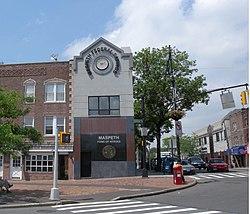Maspeth, Queens
| Maspeth | |
|---|---|
| Neighborhood of Queens | |

Maspeth Savings Bank
|
|
| Coordinates: 40°43′23″N 73°54′45″W / 40.72306°N 73.91250°WCoordinates: 40°43′23″N 73°54′45″W / 40.72306°N 73.91250°W | |
| Country |
|
| State |
|
| County | Queens |
| Settlement | 1642 |
| Founded by | Dutch settlers |
| Named for | Maspat Indians |
| Population (2010) | |
| • Total | 34,981 |
| Ethnicity | |
| • White | 75.7% |
| • Black | 2.2% |
| • Asian | 10.9% |
| • Other | 13.9% |
| Economics | |
| • Median income | $92,075 |
| ZIP code | 11378 |
| Area code(s) | 718, 347, 917 |
Maspeth is a residential and commercial community in the borough of Queens in New York City. It was founded in the early 17th century by Dutch and English settlers. Neighborhoods sharing borders with Maspeth are Woodside to the north; Sunnyside to the northwest; Greenpoint, Brooklyn to the west; East Williamsburg, Brooklyn to the southwest; Fresh Pond and Ridgewood to the south; and Middle Village and Elmhurst to the east.
The name "Maspeth" is derived from the name of Mespeatches Indians, one of the 13 main Indian tribes that inhabited Long Island. It is translated to mean "at the bad waterplace" relating to the many stagnant swamps that existed in the area.
The area known today as Maspeth was chartered by New Netherlanders and English settlers in the early 17th century. The Dutch had purchased land in the area known today as Queens in 1635, and within a few years began chartering towns. In 1642, they settled Maspat, under a charter granted to Rev. Francis Doughty, making Maspeth the first English settlement in Queens; the deed that was signed between the Native Americans and the settlers was the first one signed on Long Island. As part of the deed's signature, the "Newtown Patent" granted 13,000 acres (5,300 ha) to settlers. Conflicts with the Maspat tribe forced many settlers to move to what is now Elmhurst in 1643. The settlement was leveled the following year in an attack by Native Indians, and the surviving settlers returned to Manhattan.
...
Wikipedia
